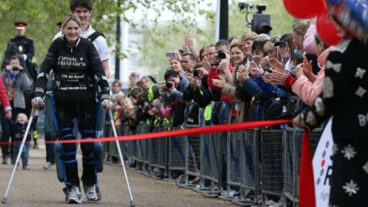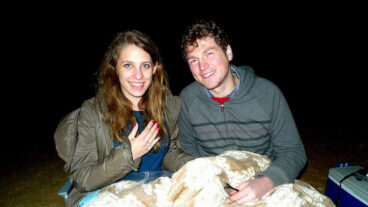by SUSAN KARLIN
Read the story as it appeared in Forbes:
Page 1|Page 2|Page 3
Israel, by necessity, has become the hotbed for counterterrorism research. Innovating well out of proportion to its size, Israel has spawned companies selling guns that shoot around corners, software that translates dog barks into English-language warnings and lasers that can detect explosives from 100 feet away. Working their way through labs now are intelligent robotic cameras, and nanolasers and nuclear resonance imagers to detect chemical and bioweapons.
“Much of the homeland security technology in the U.S. is 20 years old. It is unsuitable because the nature of the threat has changed,” says Dan Inbar, the Israeli founder of the Homeland Security Research Corp., a Washington, D.C. consultancy.
Israeli exports of homeland security equipment will hit $300 million this year, up 22% per year since 2002, estimates Inbar. The global trade in antiterror gear and consulting services is expected to grow from $46 billion to $178 billion by 2015. (The U.S. accounts for half.)
The Corner shot (Price: $5,000 to $15,000)
Urban warfare means fighting in tight quarters, but a rifle-toting soldier can’t shoot around walls, under cars or through an overhead window without sticking his head into harm’s way. Problem solved: Corner Shot, an attachment for automatic weapons, handguns and grenade launchers, swivels 63 degrees to each side of the barrel. Ammo is stored in the attachment. A video camera in the front sends an image of the target back to a monitor near the trigger. Unveiled by Corner Shot Holdings in 2003, the device has been sold in more than 15 countries, including the U.S.
X-Ray Vision (Price: still in testing.)
Superman has it. Now humans can, too. Camero’s portable radar device uses ultrawideband radio frequency to penetrate almost any kind of wall and capture high-resolution, 3-D moving images of what’s behind it. No longer do rescuers and soldiers fearing an ambush have to drill holes and insert fiber-optic cameras or depend on fuzzy images from sonarlike sound amplifiers. The Camero device picks up reflected signals from as far away as 20 meters to produce images of the physical objects in the signals’ return path. Motorola is an investor. A prototype should be ready by next summer.
The Invisible Fence (Price: $20,000 to $300,000)
Attendees at the 2004 Olympics in Athens were watched–and monitored–by cameras enhanced with artificial intelligence, made by Controp Precision Technologies. The cameras can distinguish humans from other moving objects and lock on their subjects, day or night. Guards will get an alert and can switch to manual mode and zoom in on the target. U.S. troops are using Controp cameras in Afghanistan. Just out is a 1.5-pound wireless version for mounting onto unmanned air vehicles and balloons during reconnaissance missions.
Bomb Jammer (Price: $1,500 and up)
Like a Swiss Army knife of electronic warfare, the C-Guard from Netline Communications Technologies in Tel Aviv can jam indoor cordless phones, cellular phones and satellite phones, as well as VHF, UHF and GPS signals, but leave the military radio spectrum alone. Can also be used to thwart bombs detonated remotely by seemingly dormant cell phones. Clients include NATO and the U.S. military.
Forgery Finder (Price: $600 to $3,000)
The Smart Document Reader from I-SEC Technologies claims a 97% accuracy rate at spotting forged passports and 90% for other ID cards. Documents are simultaneously scanned with visible, ultraviolet and infrared light to check for hidden watermarks. These high-res scans can be checked against official versions stored in a database to make sure things like expiration dates conform. In use in big airports in Europe, Africa and the Middle East. Successfully tested at the Newark, N.J. airport.
Explosives Detectors (Price: still in testing)
The Sensobot from Laser Detect Systems Ltd. can detect and identify common explosives from 150 feet away by picking up the spectral fingerprint of bomb materials, even traces left on a person working in a bomb factory. Prototypes due this year. The Peroxide Explosive Tester, or PET, developed at Israel’s Technion Institute, is a $30 disposable device the size of a pen that detects bomb materials from the peroxide family, which are cheap to get and hard to spot. It releases a mixture of three chemicals that turn green when they encounter such improvised explosives.
Liar Detector (Price: $200,000)
An airport security guard’s greatest fear is letting through terrorists smart enough to stay off the watch list. Suspect Detection Systems came up with a machine to smoke them out. A passenger puts his passport on a scanner and one hand on a sensor. The machine starts asking increasingly tough questions in the official language of the passport-issuing country. Artificial intelligence software monitors physiological responses through the sensor. Agents pull aside those who fail the test. The company claims a 96% accuracy rate after two years of testing. Slated to go into use next year in Israeli and U.S. airports, as well as Gaza Strip checkpoints.
Dog Translator (Price: $10,000 and up)
Worn on a collar or mounted on a wall, the Dog Bio Security System translates barking into alarms for police or military. Bio-Sense Technologies spent two years capturing the sound waves of woofs and arfs, encoding them to be read by a digital signal processor. All dogs emit the same type of bark when they sense trouble. The device can distinguish this bark from a dog’s “Hello.” A consumer version costs $100. A high-end version costs tens of thousands of dollars but is still 25% the cost of video surveillance.












